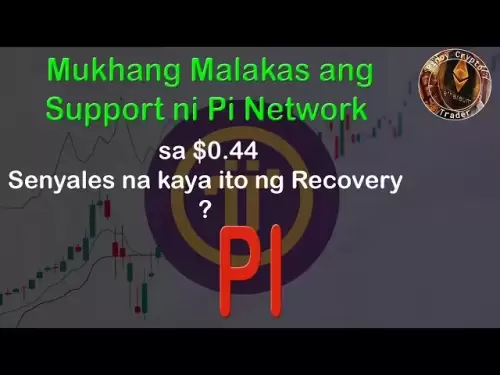-
 Bitcoin
Bitcoin $108,708.8110
0.60% -
 Ethereum
Ethereum $2,561.6057
1.91% -
 Tether USDt
Tether USDt $1.0001
-0.03% -
 XRP
XRP $2.2795
0.57% -
 BNB
BNB $662.2393
1.00% -
 Solana
Solana $153.1346
3.74% -
 USDC
USDC $1.0000
0.00% -
 TRON
TRON $0.2877
0.97% -
 Dogecoin
Dogecoin $0.1710
3.93% -
 Cardano
Cardano $0.5871
1.61% -
 Hyperliquid
Hyperliquid $39.6663
1.68% -
 Sui
Sui $2.9032
0.79% -
 Bitcoin Cash
Bitcoin Cash $496.1879
1.71% -
 Chainlink
Chainlink $13.5807
3.01% -
 UNUS SED LEO
UNUS SED LEO $9.0777
0.61% -
 Stellar
Stellar $0.2514
4.51% -
 Avalanche
Avalanche $18.1761
1.86% -
 Shiba Inu
Shiba Inu $0.0...01173
1.72% -
 Toncoin
Toncoin $2.8010
-4.23% -
 Hedera
Hedera $0.1594
3.21% -
 Litecoin
Litecoin $87.0257
-0.53% -
 Monero
Monero $319.1217
1.79% -
 Polkadot
Polkadot $3.3853
0.68% -
 Dai
Dai $0.9999
-0.01% -
 Ethena USDe
Ethena USDe $1.0003
0.02% -
 Bitget Token
Bitget Token $4.3420
-0.97% -
 Uniswap
Uniswap $7.3772
1.39% -
 Aave
Aave $286.6277
5.61% -
 Pepe
Pepe $0.0...09994
2.33% -
 Pi
Pi $0.4589
1.76%
Should I reduce my position when SUI's MVRV indicator exceeds 3?
When SUI's MVRV exceeds 3, consider reducing your position due to potential overvaluation, but also analyze other indicators and market trends before deciding.
Apr 25, 2025 at 05:07 am

When considering whether to reduce your position in SUI (a hypothetical cryptocurrency) when its Market Value to Realized Value (MVRV) indicator exceeds 3, it's essential to understand the implications of this metric and how it can inform your trading decisions. The MVRV ratio is a popular tool among crypto traders for assessing the market's sentiment towards a particular cryptocurrency. It compares the market value of a cryptocurrency to its realized value, offering insights into whether the asset is overvalued or undervalued.
Understanding the MVRV Indicator
The MVRV indicator calculates the ratio of the market capitalization of a cryptocurrency to its realized capitalization. The market capitalization is simply the total value of all coins in circulation at the current market price. In contrast, the realized capitalization is calculated by valuing each coin at the price at which it last moved on the blockchain, providing a more fundamental value of the cryptocurrency.
When the MVRV ratio exceeds 3, it suggests that the cryptocurrency might be overvalued. Historically, such high MVRV values have been associated with market tops, indicating that a correction might be imminent. This is because the market value has significantly deviated from the realized value, often driven by speculative buying.
Historical Performance and MVRV
Analyzing the historical performance of SUI in relation to its MVRV can provide valuable insights. If past data shows that SUI experienced significant price corrections after its MVRV exceeded 3, this could be a strong signal to consider reducing your position. However, it's crucial to look at other factors as well, such as market trends, news, and overall sentiment.
Other Factors to Consider
While the MVRV ratio is a useful indicator, it should not be the sole determinant of your trading decisions. Other technical indicators, such as the Relative Strength Index (RSI) and Moving Averages, can provide additional context. Fundamental analysis, including the project's development progress, partnerships, and regulatory news, should also be considered.
Risk Management Strategies
Reducing your position when the MVRV exceeds 3 can be part of a broader risk management strategy. This might involve setting stop-loss orders to automatically sell a portion of your holdings if the price drops to a certain level. Alternatively, you might choose to diversify your portfolio by investing in other cryptocurrencies or assets that are less correlated with SUI.
Practical Steps to Reduce Your Position
If you decide to reduce your position in SUI based on the MVRV indicator, here are the practical steps you can follow:
- Log into your trading platform: Ensure you have access to your account where SUI is held.
- Check the current MVRV value: Verify that the MVRV for SUI is indeed above 3.
- Determine the amount to sell: Decide how much of your SUI holdings you want to sell. This could be a percentage of your total position or a fixed amount.
- Place a sell order: Navigate to the trading interface and enter the amount of SUI you wish to sell. You can choose between a market order, which sells at the current market price, or a limit order, which sells at a specified price.
- Monitor the transaction: Ensure that the sell order is executed and that the funds are credited to your account.
- Review your portfolio: After reducing your position, reassess your overall portfolio to ensure it aligns with your investment strategy.
Emotional and Psychological Considerations
Trading decisions, including those based on indicators like MVRV, can be influenced by emotions. Fear of missing out (FOMO) or fear of loss can lead to impulsive decisions. It's important to maintain a disciplined approach and stick to your trading plan, even when the MVRV suggests a potential correction.
Consulting with Other Traders and Analysts
Engaging with the crypto community can provide additional perspectives on whether to reduce your position in SUI. Forums, social media groups, and trading communities often discuss market indicators and share insights that can help you make more informed decisions. However, always verify information from multiple sources before acting on it.
Using MVRV in Conjunction with Other Tools
While the MVRV can be a powerful indicator, using it in isolation can lead to false signals. Combining it with other tools can enhance its effectiveness. For instance, if the MVRV is high and the RSI is also in overbought territory, this could reinforce the decision to reduce your position. Conversely, if other indicators suggest a different market condition, you might want to reconsider your strategy.
Long-Term vs. Short-Term Trading
Your decision to reduce your position based on the MVRV might also depend on your trading horizon. Long-term investors might be less concerned about short-term fluctuations indicated by the MVRV, while short-term traders might be more inclined to act on such signals. Understanding your investment goals and time frame is crucial in making the right decision.
Frequently Asked Questions
Q: Can the MVRV indicator be used for all cryptocurrencies?
A: While the MVRV indicator can be applied to any cryptocurrency, its effectiveness can vary. For less liquid or newer cryptocurrencies, the data might be less reliable, and other factors might have a more significant impact on price movements.
Q: How often should I check the MVRV indicator for SUI?
A: The frequency of checking the MVRV indicator depends on your trading strategy. For active traders, daily or even hourly checks might be necessary, while long-term investors might only need to monitor it weekly or monthly.
Q: Are there any tools or platforms that provide real-time MVRV data for SUI?
A: Yes, several crypto analytics platforms offer real-time MVRV data for various cryptocurrencies, including SUI. Examples include Glassnode, CoinMetrics, and CryptoQuant. These platforms often require a subscription for access to detailed data.
Q: What other indicators should I use alongside the MVRV to make trading decisions for SUI?
A: In addition to the MVRV, you might consider using the Relative Strength Index (RSI), Moving Averages, Bollinger Bands, and the On-Balance Volume (OBV) indicator. Each of these can provide different insights into market conditions and help you make more informed trading decisions.
Disclaimer:info@kdj.com
The information provided is not trading advice. kdj.com does not assume any responsibility for any investments made based on the information provided in this article. Cryptocurrencies are highly volatile and it is highly recommended that you invest with caution after thorough research!
If you believe that the content used on this website infringes your copyright, please contact us immediately (info@kdj.com) and we will delete it promptly.
- Bitcoin Wallet Hack? Coinbase Exec Sounds the Alarm on $8B Whale Movement
- 2025-07-07 18:30:12
- Mercado Bitcoin, Tokenization, and XRP Ledger: A Latin American Power Play
- 2025-07-07 18:30:12
- Ripple's RLUSD: Revolutionizing Cross-Margin Trading for Institutions
- 2025-07-07 18:35:12
- Babylon, Bitcoin, and the EVM Mainnet: A New Era for BTCFi?
- 2025-07-07 16:30:11
- Queen Elizabeth Coin Sells for £31,000: A Royal Fortune in Your Pocket?
- 2025-07-07 16:30:11
- XRP Price Check: Will Resistance Trigger a July Drop?
- 2025-07-07 17:10:12
Related knowledge
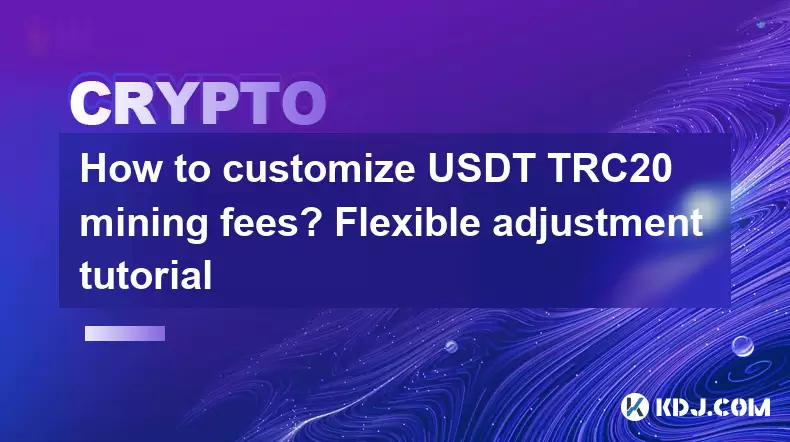
How to customize USDT TRC20 mining fees? Flexible adjustment tutorial
Jun 13,2025 at 01:42am
Understanding USDT TRC20 Mining FeesMining fees on the TRON (TRC20) network are essential for processing transactions. Unlike Bitcoin or Ethereum, where miners directly validate transactions, TRON uses a delegated proof-of-stake (DPoS) mechanism. However, users still need to pay bandwidth and energy fees, which are collectively referred to as 'mining fe...
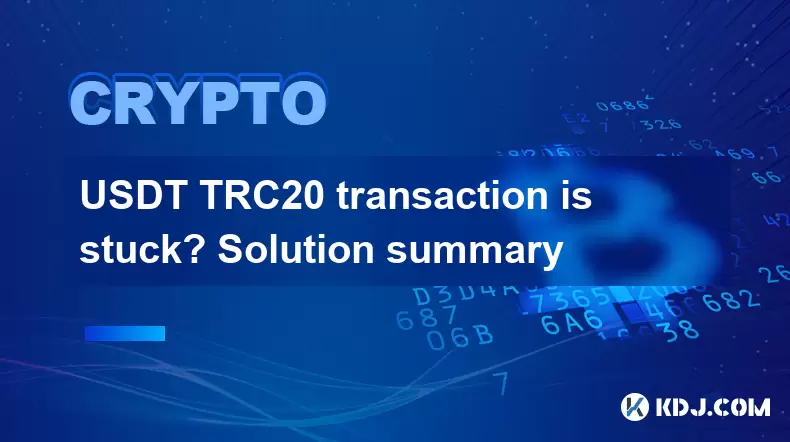
USDT TRC20 transaction is stuck? Solution summary
Jun 14,2025 at 11:15pm
Understanding USDT TRC20 TransactionsWhen users mention that a USDT TRC20 transaction is stuck, they typically refer to a situation where the transfer of Tether (USDT) on the TRON blockchain has not been confirmed for an extended period. This issue may arise due to various reasons such as network congestion, insufficient transaction fees, or wallet-rela...
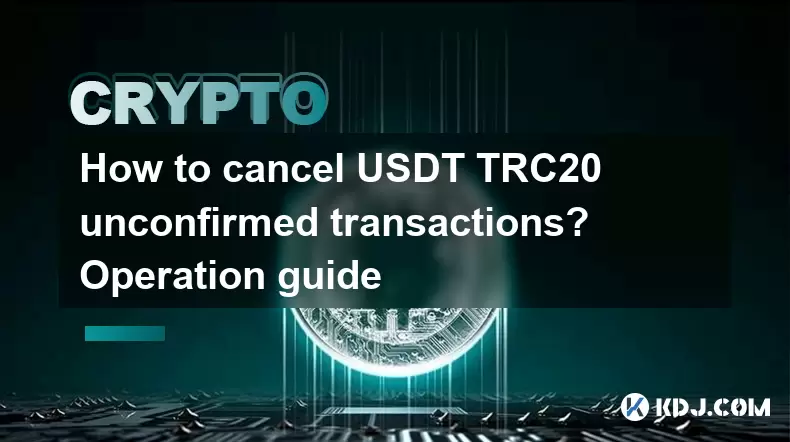
How to cancel USDT TRC20 unconfirmed transactions? Operation guide
Jun 13,2025 at 11:01pm
Understanding USDT TRC20 Unconfirmed TransactionsWhen dealing with USDT TRC20 transactions, it’s crucial to understand what an unconfirmed transaction means. An unconfirmed transaction is one that has been broadcasted to the blockchain network but hasn’t yet been included in a block. This typically occurs due to low transaction fees or network congestio...
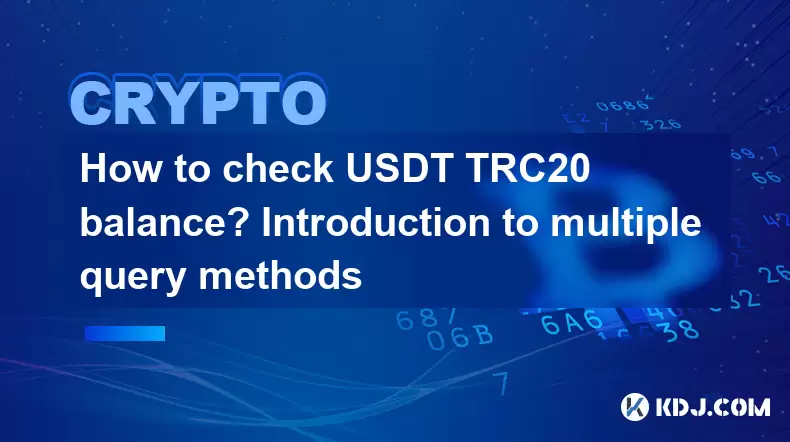
How to check USDT TRC20 balance? Introduction to multiple query methods
Jun 21,2025 at 02:42am
Understanding USDT TRC20 and Its ImportanceUSDT (Tether) is one of the most widely used stablecoins in the cryptocurrency market. It exists on multiple blockchain networks, including TRC20, which operates on the Tron (TRX) network. Checking your USDT TRC20 balance accurately is crucial for users who hold or transact with this asset. Whether you're sendi...

What to do if USDT TRC20 transfers are congested? Speed up trading skills
Jun 13,2025 at 09:56am
Understanding USDT TRC20 Transfer CongestionWhen transferring USDT TRC20, users may occasionally experience delays or congestion. This typically occurs due to network overload on the TRON blockchain, which hosts the TRC20 version of Tether. Unlike the ERC20 variant (which runs on Ethereum), TRC20 transactions are generally faster and cheaper, but during...

The relationship between USDT TRC20 and TRON chain: technical background analysis
Jun 12,2025 at 01:28pm
What is USDT TRC20?USDT TRC20 refers to the Tether (USDT) token issued on the TRON blockchain using the TRC-20 standard. Unlike the more commonly known ERC-20 version of USDT (which runs on Ethereum), the TRC-20 variant leverages the TRON network's infrastructure for faster and cheaper transactions. The emergence of this version came as part of Tether’s...

How to customize USDT TRC20 mining fees? Flexible adjustment tutorial
Jun 13,2025 at 01:42am
Understanding USDT TRC20 Mining FeesMining fees on the TRON (TRC20) network are essential for processing transactions. Unlike Bitcoin or Ethereum, where miners directly validate transactions, TRON uses a delegated proof-of-stake (DPoS) mechanism. However, users still need to pay bandwidth and energy fees, which are collectively referred to as 'mining fe...

USDT TRC20 transaction is stuck? Solution summary
Jun 14,2025 at 11:15pm
Understanding USDT TRC20 TransactionsWhen users mention that a USDT TRC20 transaction is stuck, they typically refer to a situation where the transfer of Tether (USDT) on the TRON blockchain has not been confirmed for an extended period. This issue may arise due to various reasons such as network congestion, insufficient transaction fees, or wallet-rela...

How to cancel USDT TRC20 unconfirmed transactions? Operation guide
Jun 13,2025 at 11:01pm
Understanding USDT TRC20 Unconfirmed TransactionsWhen dealing with USDT TRC20 transactions, it’s crucial to understand what an unconfirmed transaction means. An unconfirmed transaction is one that has been broadcasted to the blockchain network but hasn’t yet been included in a block. This typically occurs due to low transaction fees or network congestio...

How to check USDT TRC20 balance? Introduction to multiple query methods
Jun 21,2025 at 02:42am
Understanding USDT TRC20 and Its ImportanceUSDT (Tether) is one of the most widely used stablecoins in the cryptocurrency market. It exists on multiple blockchain networks, including TRC20, which operates on the Tron (TRX) network. Checking your USDT TRC20 balance accurately is crucial for users who hold or transact with this asset. Whether you're sendi...

What to do if USDT TRC20 transfers are congested? Speed up trading skills
Jun 13,2025 at 09:56am
Understanding USDT TRC20 Transfer CongestionWhen transferring USDT TRC20, users may occasionally experience delays or congestion. This typically occurs due to network overload on the TRON blockchain, which hosts the TRC20 version of Tether. Unlike the ERC20 variant (which runs on Ethereum), TRC20 transactions are generally faster and cheaper, but during...

The relationship between USDT TRC20 and TRON chain: technical background analysis
Jun 12,2025 at 01:28pm
What is USDT TRC20?USDT TRC20 refers to the Tether (USDT) token issued on the TRON blockchain using the TRC-20 standard. Unlike the more commonly known ERC-20 version of USDT (which runs on Ethereum), the TRC-20 variant leverages the TRON network's infrastructure for faster and cheaper transactions. The emergence of this version came as part of Tether’s...
See all articles























